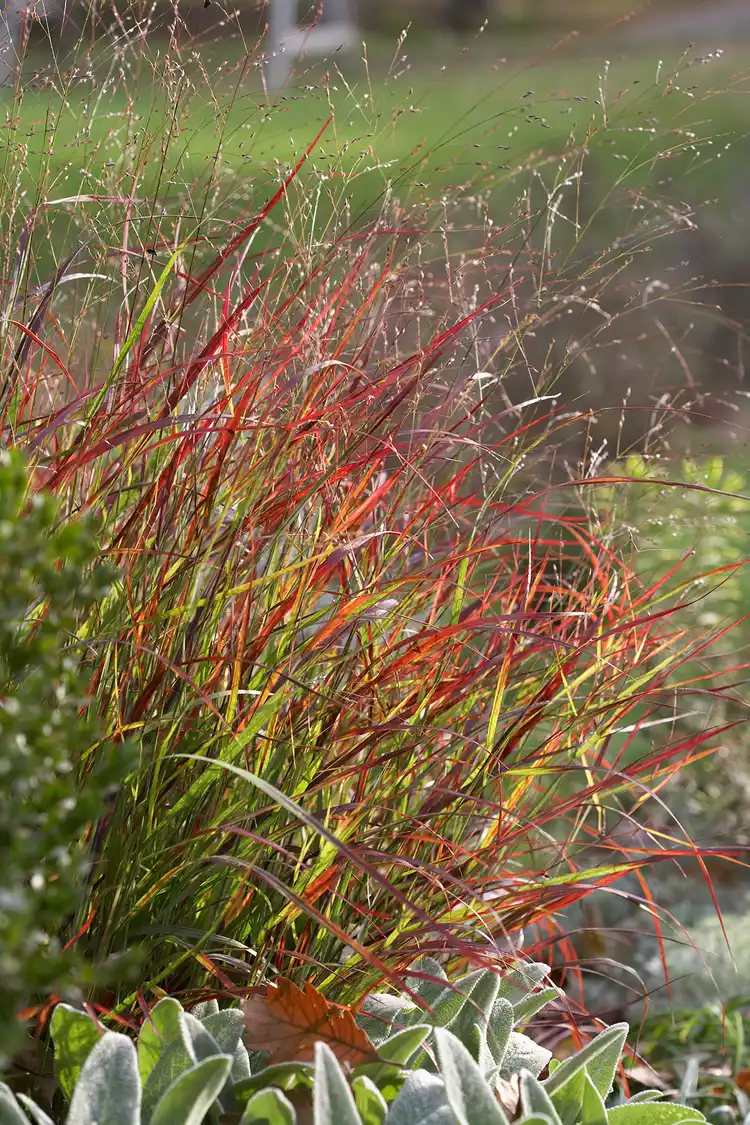Birds Will Flock to Your Garden When You Plant Grasses for Wildlife

Ornamental grasses provide beautiful texture, movement, and color to the landscape. They make excellent accent plants for beds and borders, and many even work well in containers. Adding grasses for wildlife will bring birds to flock and feed in your garden. These bird-friendly grasses offer seed-filled plumes and dense foliage for cover and nesting material.
Allow ornamental grasses birds love to remain standing with their seed heads through the winter. Then, during the following spring, before the new growth appears, cut your grasses back to a few inches above the ground.
Here are the ornamental grasses to plant in your garden to keep the birds coming back year after year.
1. Switchgrass
One of the best perennials with showstopping fall-foliage color and texture is switchgrass. Selections of this gorgeous North American native prairie grass such as 'Shenandoah' and 'Rotstrahlbusch' have outstanding red fall color. 'Heavy Metal' is a variety that features metallic-blue leaves, which turn yellow in autumn.
Ground-feeding songbirds and gamebirds eat the fallen seeds from this grass's showy seed plumes. Reseeding is a problem for some varieties in certain areas. Cover exposed soil with a 3-inch layer of mulch to prevent your switchgrass from spreading out of bounds. Or plant it in a naturalist garden where it can spread out as it pleases.
Name: Panicum virgatum
Growing Conditions: Full sun to part shade in medium to wet soil
Size: Up to 6 feet tall
Zones: 5-9
Buy It: Shenandoah Switch Grass 2-Pack ($40, The Home Depot)
2. Blue Fescue
The steely-blue foliage of blue fescue makes a striking garden accent. Though the seed heads of this drought-tolerant ornamental grass aren't very showy, it's an excellent grass for wildlife because birds like to eat the seeds. They'll also use the dense foliage as winter cover and nesting material.
This low-growing grass forms tidy mounds that work well for edging your beds and borders or as a groundcover in a sunny spot.
Name: Festuca glauca
Growing Conditions: Full sun and well-drained soil
Size: Up to 1 foot tall
Zones: 4-8
Buy It: Elijah Blue Fescue Grass ($30, The Home Depot)
3. Little Bluestem
Named for the lavender-blue color on its stem bases, little bluestem is a native warm-season grass common in tallgrass prairie areas. However, the most striking feature of this plant is its bronze-orange fall foliage color that lasts through winter snows.
Little bluestem is a wonderful grass for wildlife because its seeds feed birds—including cardinals, buntings, finches, grosbeaks, sparrows, and towhees—from fall into spring. Birds such as field sparrows and common yellowthroats like to build nests in little bluestem's dense foliage.
Name: Schizachyrium scoparium
Growing Conditions: Full sun and well-drained soil
Size: Up to 4 feet tall
Zones: 3-9
4. Canada Wild Rye
Another North American native ornamental grass, Canada wild rye looks right at home in a low-maintenance prairie garden. This fast-growing, short-lived perennial grass has beautiful, curving seed heads that look like cultivated rye spikes. When there's a breeze, these seedy spikes bob and sway, living up to another common name for this plant: nodding wild rye.
Birds love to eat the seeds and rely on the foliage for making nests. When landscaping with this ornamental grass, avoid planting it in areas frequented by dogs or children because the seed heads are somewhat prickly and could cause injury.
Name: Elymus canadensis
Growing Conditions: Full sun and well-drained soil
Size: Up to 5 feet tall
Zones: 3-9
Buy It: Canada Wild Rye Native Starter Plant ($7, Etsy)
5. Indian Grass
Another native plant found in tallgrass prairies, Indian grass makes the perfect habitat for ground-nesting birds such as mourning doves and bobwhite quail. Many birds love to eat the seeds in this plant's feathery, light brown plumes.
Indian grass adds a bold vertical accent to the landscape with its upright blue-green foliage, which turns orange-yellow in autumn. Look for the variety 'Sioux Blue,' which sports metallic-blue foliage that shines in natural gardens and prairie plantings. Indian grass is also helpful in managing slope erosion.
Name: Sorghastrum nutans
Growing Conditions: Full sun and well-drained soil
Size: Up to 5 feet tall
Zones: 4-9
Buy It: Ornamental Indian Grass Seeds ($3, Etsy)
6. Tufted Hairgrass
One of the few ornamental grasses for wildlife that grows in a shady garden, tufted hairgrass is a cool-season native species. Game birds and songbirds love to eat the seeds, and in wet areas, this fine-textured grass provides cover to nesting waterfowl. Its short height makes tufted hairgrass a good choice for smaller landscapes and urban gardens. Try planting it in a border with shade-loving perennials such as ferns and hostas.
Name: Deschampsia cespitosa
Growing Conditions: Part shade and moist to wet, well-drained soil
Size: Up to 3 feet tall
Zones: 4-9
Buy It: Deschampsia Cespitosa Seeds ($7, Amazon)